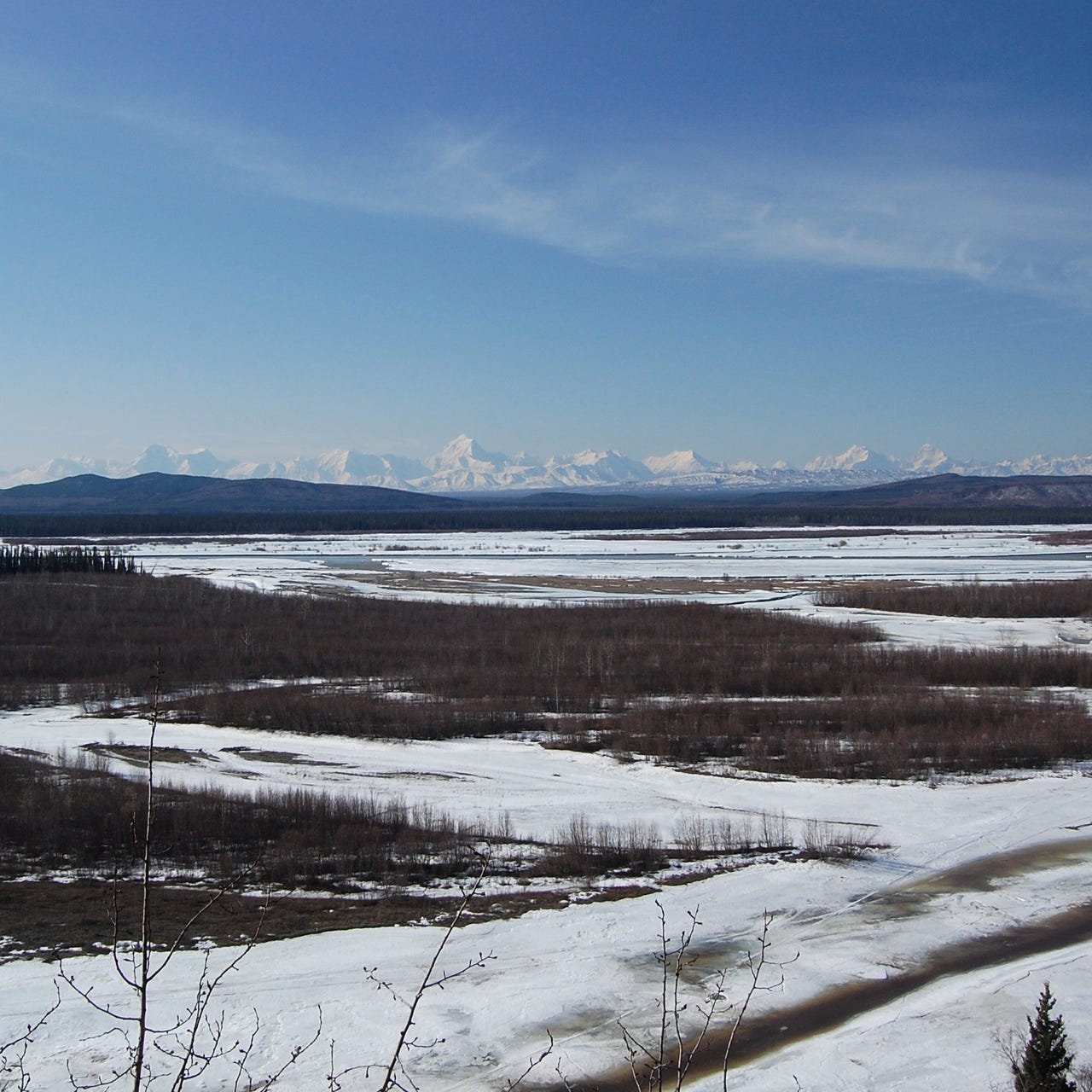Numlock Sunday: Rick Thoman on how Alaskan sea ice is really doing

By Dave Levinthal
Welcome to the Numlock Sunday edition.
This week, Walt’s good friend Dave Levinthal is filling in for him while he’s on vacation, and speaking to Rick Thoman, a climate specialist at the Alaska Center for Climate Assessment. They spoke about what the reality is on the ice up in Alaska, and how it’s already having massive ramifications for life up there.
Thoman’s work can found at the IARC and on his Substack, the Alaska and Arctic Climate Newsletter.
This interview has been condensed and edited.
Before we start, if you could just give me your name and your title?
So my name is Rick Thoman, and I work as an Alaska and Arctic climate specialist at the Alaska Center for Climate Assessment and Policy, which is one of the groups within the International Arctic Research Center at the University of Alaska Fairbanks.
As a lover of the Arctic myself, who has traveled there somewhat extensively over the years, I’ve been fascinated by your Substack because there’s really nothing like it that I read that gets into the science behind sea ice and Arctic climate change. Among all the different things that people are concerned about here in the year of our Lord 2025, why should Arctic sea ice rank among them?
Well, Dave, thanks for having me. And Arctic sea ice, of course, plays an important role in the globe’s climate system. It serves as the Northern Hemisphere’s refrigerator. Sea ice is covered with snow, and it is an extremely effective reflector of the sun in contrast to open water, which, of course, is a very dark surface and absorbs heat from the sun. Now in the Arctic, the absorbing the sun part is only an issue during mid-summer.
The Arctic gets little or — depending on your latitude — no sun during the winter months. And so that absorption of solar heat is really an issue in the summertime. That’s because of the difference in the very dark open water versus extremely reflective ice with snow on it. That is such a big difference that even relatively small losses can influence the Northern Hemisphere climate pretty readily. And, of course, we’ve had much more than modest losses over the last 50 years.
You live in Alaska. What are you seeing locally, as somebody who lives there and travels through the state, that perhaps wouldn’t have been the case, or present, 30 or 40 years ago?
Certainly one of the most profound changes is the loss of autumn sea ice. And that is a big deal for people’s lives and livelihoods, right down to the what’s for dinner tonight questions. In the late 20th century, when we had lots of multi-year ice in the Arctic, the ice edge typically never got very far north of the northern Alaska coast. Some years, it never completely cleared. Nowadays, the ice edge, by the time we get to the middle of September, is typically hundreds of miles to the north of the Alaska coast.
That has resulted in a sea change in the autumn climate in northern and northwest Alaska. It also impacts the resources that Alaskans in those parts of the world rely on for their living and for their cultural sustenance and nutritional needs.
What is the relationship between sea ice and Arctic climate in general — and fire, if you will. Specifically: wildfires and forest fires that seem to be more commonplace today than they were maybe a generation or two ago?
There is a strong correlation related to the warming climate. The boreal forest is already evolved to take advantage of wildfire as a natural part of the boreal system. The fuels are drying; they’re drying out earlier because of, in part, warmer air temperatures. The same factors are influencing, to some extent, sea ice. But interestingly, Dave, there’s been some work done here lately: a recently published paper indicating that it’s potentially more than just a correlation between more wildfires and less sea ice, but rather there may be a causative link in there too, affecting the overall climate system.
One place that I’ve traveled is Greenland, and Greenland is in the news for political reasons lately, obviously. But when I think of Greenland, I think of walking on the ice sheet, or standing on a ridge overlooking the Ilulissat Icefjord — these building- and mountain-sized blocks of ice moving along, and you could almost visibly perceive their motion.
From all I understand, the melt and the movement are faster today than they’ve been in modern history. What concerns you when you think about Greenland and the effects of climate change in that particular portion of the Arctic?
When we look at impacts from climate change, we have to look hard at Greenland. In many ways, on the Greenland ice sheet, the ice age has never ended. It’s still an ice environment. But every year since 1998, the Greenland ice sheet has lost total mass between melt ice breaking off and calving into the ocean every year since 1998, and that is contributing to sea level rise. Ice in the Arctic Ocean formed from frozen seawater (whether that’s ice or water) doesn’t contribute to changes in sea level very much. It’s that land ice that is really an important driver.
Additionally, and this has gotten a lot of press lately, the loss of Greenland ice as it calves off or runs off after it melts into the North Atlantic — is that going to disrupt, possibly critically disrupt, the Atlantic overturning meridional circulation? That deep ocean circulation brings water from Antarctica all the way to the North? And if that were to greatly weaken, we could see really dramatic impacts to the climate of Europe. So there’s the potential for multi-pronged impacts to our climate from having less ice in the Greenland ice sheet.
These seem to be the phenomena that aren’t widely appreciated, I think it’s fair to say. When you hear people say, “Oh well, we had such a cold winter, climate change is not real, or it’s overblown, or people are making much ado about nothing that’s going to affect us in our lifetime,” what response do you have for those that remain skeptical that what you’re describing is something that is acute and present?
I would say that it already is having an impact. It’s not a future scenario. It’s not speculation. Here in Alaska, everyone knows that the climate is changing because it’s impacting everything, like the roads that I drive on to and from work, as permafrost thaws. Those roads have been there for a hundred years, and permafrost thaw just in the last 20 years has become dramatically worse. That means that we, as a society, are paying a lot of money because roads are expensive to maintain. We’re paying a lot of money to keep repairing the same places over and over again.
In western Alaska, the loss of sea ice is affecting what’s for dinner tonight. It’s affecting the availability and the movement of marine mammals, of fish that are commercially or subsistence harvested. So things are already changing. There’s lots of evidence that even at the lower latitudes, the changes in the Arctic are at least episodically impacting the day-to-day weather. That can include, in the wintertime, more extreme cold snaps.
It’s important to understand that that is not a global phenomenon. For instance, in the Arctic, I think everywhere in the Arctic in a recent paper, there’s actually less of that variation. In the mid-latitude, it’s more. I think the important point, though, is one that’s been stressed a lot. Whatever’s happening outside my window or your window, that’s probably not indicative of what’s happening in the whole world.
I’m glad you brought up animals, because we will often see dramatic, harrowing pictures of polar bears not able to walk across the ice, et cetera. But when you look at the animal element of what we’re discussing, where do you see some of the biggest challenges or biggest areas of concern, particularly as it pertains to the survivability of key Arctic species?
Certainly, polar bears are the iconic Arctic species. I’m not a biologist; I’m a climate person. But my understanding is that different regions in the Arctic, some regions, they’re faring okay. Others, not well at all. But beyond polar bears, species like ice seals, species like walrus, like bowhead whale that are so important (not just in Alaska, but also around the Arctic as culturally important and as food sources), things are definitely changing. Most ice seal species require some stable sea ice in order to give birth to their pups. Whales, of course, give birth in water. But if all of the ice goes away, that is going to be a serious problem for some species of ice seals.
We have already seen in the Bering Sea that during the years when there’s extremely low sea ice, most recently in 2018 and 2019, we saw wholesale movement of southern Bering Sea fish species. They are really just an extension of the North Pacific. We saw those more southern species move rapidly northward all the way to the Bering Street. Typically, the northern Bering Sea is much more of an Arctic marine ecosystem. But we saw in 2018 and 2019 how rapidly the marine ecosystem and the fish populations responded.
That makes sense, right? Fish, seals, walrus, all animals, they’re pretty much going to live where they can, and they don’t live where they can’t. With the proviso, of course, can they get there? Well, if you’re a fish in the southern Bering Sea, the only thing between you and the Bering Strait is lots of water, and you’re built to swim.
You’ve served up a heaping portion of food for concern. At the same time, why are you optimistic about where this is all going? Should people in general feel optimistic that some of these bad things or concerning directions can be turned around?
Well, we know humans as a species are very adaptable. Our Indigenous cultures in the Arctic are very adaptable — been here for thousands of years. Many of the cultures in Alaska have been here since the end of the last ice age, and they have gone through and survived through and thrived through environmental change before.
And that’s really true of people everywhere, right? So we are adaptable. Things are changing, but if we take what’s happening, we know how to turn this around. The problem is, of course, it’s going to take a long time. There’s no magic bullet. But if we do what we need to do to start to turn it around for our children, for our grandchildren, and at the same time adapt to the conditions that we find ourselves in, we have the potential to get through this.
Dave can be found at his outstanding newsletter:
Edited by Crystal Wang
If you have anything you’d like to see in this Sunday special, shoot me an email. Comment below! Thanks for reading, and thanks so much for supporting Numlock.
Thank you so much for becoming a paid subscriber!
Send links to me on Twitter at @WaltHickey or email me with numbers, tips or feedback at walt@numlock.news.



